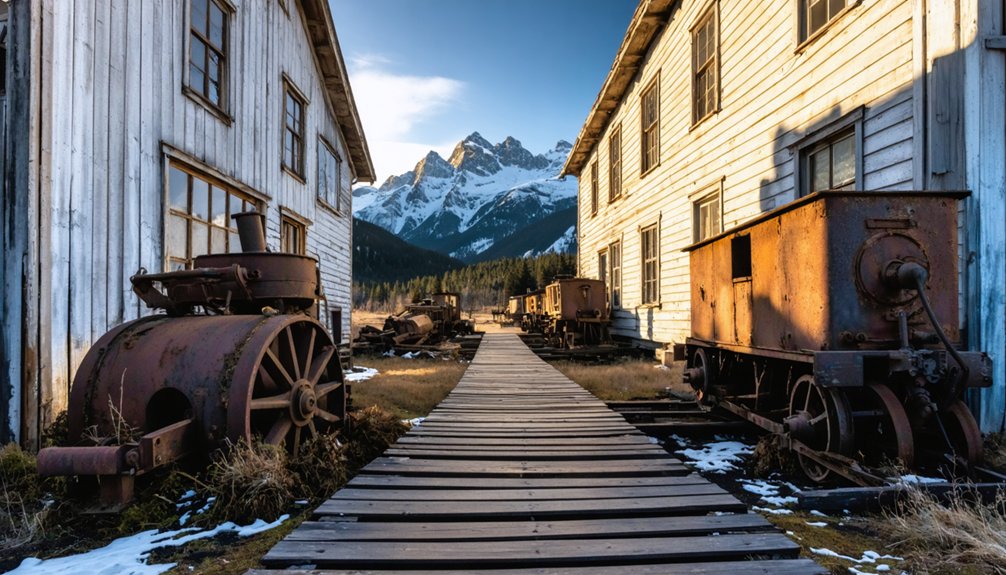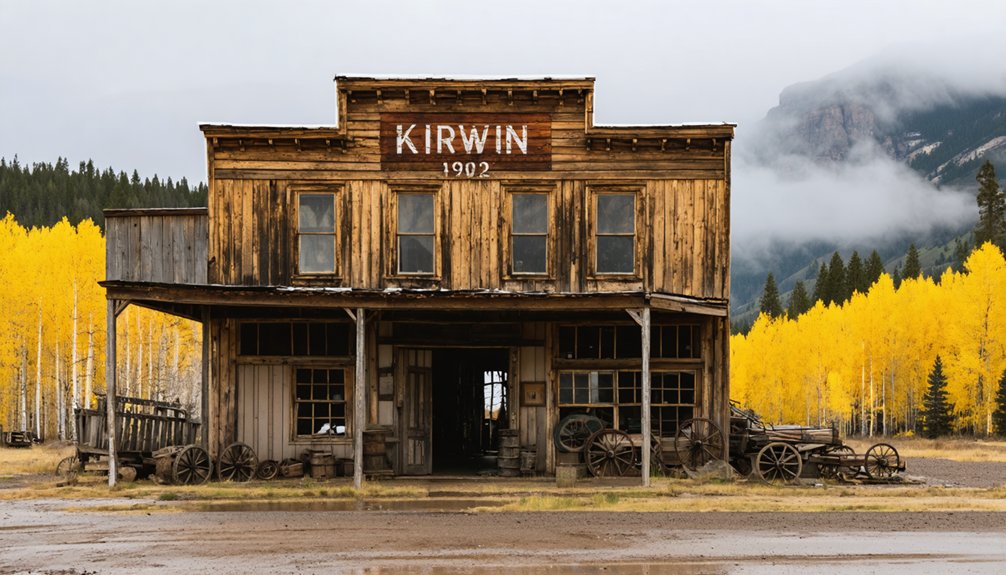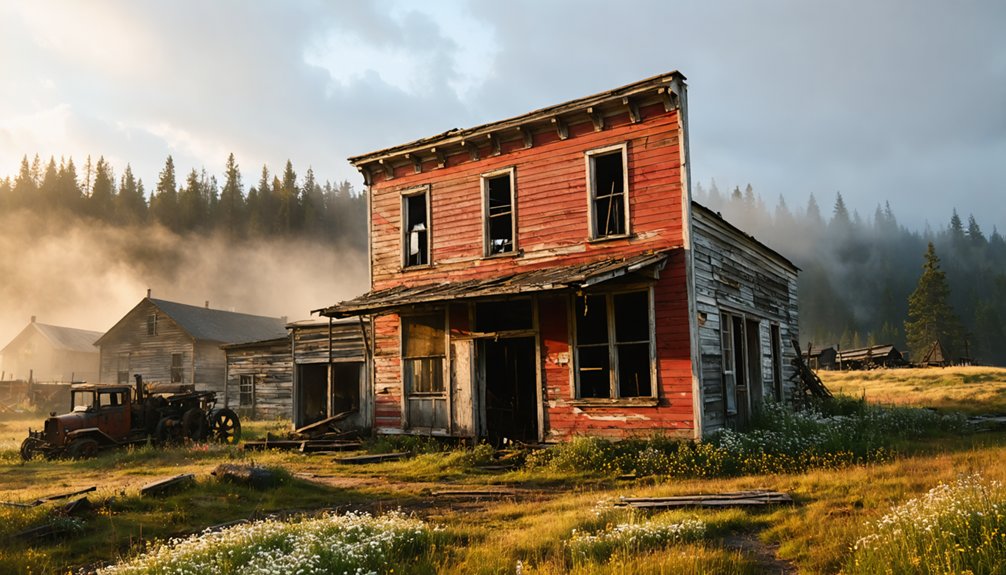Washington’s best-preserved ghost towns offer you remarkable glimpses into the state’s pioneering past. Liberty showcases gold rush ingenuity, while Claquato’s historic church stands as the oldest in the state. Molson functions as a living museum, and Nighthawk retains intact structures from the 1860s-1900s. Franklin displays coal mining relics, Monte Cristo reveals silver mining ambitions, and Govan preserves railway history. Each abandoned settlement holds stories waiting to be discovered.
Key Takeaways
- Liberty remains Washington’s oldest mining settlement, established after an 1873 gold discovery and listed on the National Register of Historic Places.
- Claquato features Washington’s oldest standing church with a unique steeple, reflecting pioneer resilience since 1853.
- Molson offers a living museum experience with preserved structures and pioneer cabins maintained by the local historical society.
- Nighthawk showcases remarkably intact structures from the 1860s-1900s, including the 1903 hotel, 1915 schoolhouse, and a functioning tavern.
- Franklin, Monte Cristo, and Govan feature abandoned mining equipment, hiking trails, and historical remnants that showcase Washington’s industrial past.
Liberty: Washington’s Gold Rush Legacy in the Cascades
Nestled in the eastern foothills of the Cascade Mountains, Liberty stands as Washington’s oldest mining settlement, a tribute to the state’s often-overlooked gold rush heritage. Founded after the 1873 gold discovery in Swauk Creek, this “living ghost town” has weathered boom-and-bust cycles while maintaining its authentic character.
Gold-flecked history meets mountain charm in Liberty, Washington’s oldest mining town—a hidden gem of frontier heritage.
You’ll discover a remarkable collection of historic structures and mining equipment, including a reconstructed arrastra—a primitive ore-crushing mill that testifies to miners’ ingenuity. Originally called Meaghersville until 1912, the town changed its name as its mining operations expanded. The area became the epicenter of gold mining in the 1870s, attracting prospectors from across the country.
The area’s unique geological significance produced unusually large nuggets and rare crystalline wire gold formations.
Liberty’s inclusion on the National Register of Historic Places in 1974 recognizes its importance to gold mining history.
Despite preservation challenges, dedicated locals continue protecting this tangible link to Washington’s frontier past, where you can still experience the spirit of American prospectors.
Claquato: Where History Survives in Sacred Structures
While Liberty preserves Washington’s mining heritage, another forgotten settlement awaits your discovery in the southwestern part of the state. Claquato, founded in 1853 by Lewis Hawkins Davis, once thrived as Lewis County’s seat until the railroad’s arrival sealed its fate.
Unlike many ghost towns, Claquato’s cultural significance lives on through two meticulously preserved landmarks. The Claquato Church—Washington’s oldest standing church with its distinctive crown of thorns steeple—and the historic cemetery remain as symbols of pioneer resilience. The name “Claquato” comes from a Native American term meaning Higher Ground.
Both are listed on the National Register of Historic Places, reflecting successful historic preservation efforts.
You’ll find the church still hosts special services, while the cemetery continues serving the community beneath its famous fir tree—tangible connections to Washington’s territorial past that you can freely explore today.
Molson: A Living Museum of the Northern Frontier
Located near the Canadian border in Okanogan County, Molson stands as one of Washington’s most extensive ghost town experiences. Founded in 1898 by George Meacham with John Molson’s financing, this mining boom town once thrived with 300 residents before being relocated in 1909 due to land disputes.
Today, you’ll find a remarkably preserved slice of pioneer life thanks to preservation efforts begun in 1960 by Harry Sherling. The Molson Historical Society maintains authentic structures including the old bank and pioneer cabins filled with period items that illuminate daily frontier existence. At its peak, the town reached a population of 700 residents with a trading area extending from 20 miles south to 10 miles into Canada. Visitors can explore the brick schoolhouse turned museum during summer tours, complete with knowledgeable local guides sharing historical insights.
Standing at 3,708 feet—Washington’s highest railroad station—this free outdoor museum offers you a tangible connection to Molson history through original buildings, mining tools, and farming equipment displayed across the site.
Nighthawk: Mining Heritage Preserved Along the Border
When you visit Nighthawk, you’ll encounter one of Washington’s best-preserved ghost towns, featuring original structures like the hotel, schoolhouse, and mining office that date back to the 1860s-early 1900s mining era.
This historic border settlement thrived under mining operators like James M. Haggerty, who developed significant operations including the self-financing Ruby Mine that produced substantial silver ore worth over $20,000 in its first year alone. The development costs of this impressive mine were completely covered by ore production during its operational years.
The remaining buildings stand as silent witnesses to Nighthawk’s importance as both a mining center and supply hub for the surrounding Okanogan County mining district, which contained notable claims such as Number One, Eagle, and Cabba registered before Washington achieved statehood. For those interested in visiting, many explorers like Tim Nas document these historic sites through social media platforms to share their findings with history enthusiasts.
Border Mining Hub Legacy
Established along the Canadian border in the late 19th century, Nighthawk stands as one of Washington Territory’s pioneering mining settlements, with some of the first registered hard rock mining claims dating back to the early 1870s.
The district flourished as miners extracted valuable lead and silver deposits using evolving mining techniques, creating a thriving economic hub that supported community evolution from remote outpost to industrial center. The land’s rich mining heritage includes property that once belonged to Okanogan Smith, patented in 1883. Visitors to Nighthawk can experience a well-preserved example of the boom towns that once dotted Northeastern Washington’s mining landscape.
- Six concentration mills processed ore before refining
- US Mineral Monument #1 marked the Summit Silver claim in 1884
- Original claims included Number One, Eagle, and Cabba by “Okanogan” Smith
- A 1,770-foot adit accessed rich veins worth $50 per ton
- Community infrastructure included hotel, schoolhouse, and mining office
The town’s eventual decline followed the familiar pattern of many mining communities—falling victim to fluctuating metal prices and increasing operational costs.
Historic Structures Standing Today
Today’s visitors to Nighthawk can still witness remarkable structures that have withstood over a century of harsh Washington weather and abandonment.
You’ll find the Nighthawk Hotel, built in 1903 by J.M. Hagerty and rebuilt after a 1910 fire, standing as a representation of the town’s architectural significance.
The 1915 schoolhouse remains intact on private land, alongside wooden false-front buildings typical of early mining establishments.
The mining office and 1939 mill building from the Kaaba Texas Mining Co. offer glimpses into industrial heritage.
Even a functioning tavern continues serving guests among these historic treasures.
While exploring these sites, remember to respect property boundaries and always prioritize safety and preparation before visiting abandoned locations.
While some structures like the log cabin assay office have been lost to time, Nighthawk’s remaining buildings represent one of Washington’s finest examples of mining-era historic preservation, though most require viewing from a respectful distance.
Franklin: Coal Mining Relics in the Shadow of Mount Rainier

Nestled along the Green River in southeast King County, Franklin stands as one of Washington’s most evocative ghost towns, offering visitors a glimpse into the state’s rich coal mining past.
The town’s historical significance extends beyond its 1880s origins, marked tragically by the 1894 coal mine disaster that claimed 37 lives.
You’ll discover the remains of this once-thriving community via the Franklin Coal Mine Trail, just an hour from Seattle.
The 2.5-mile roundtrip journey rewards explorers with:
- Concrete foundations and abandoned mining equipment
- The sealed Franklin No. 2 Mine Shaft
- A poignant cemetery with weathered gravestones
- Views of Mount Rainier and the Green River Gorge
- The site of a 1970s mine fire that created temporary hot springs
Monte Cristo: Silver Dreams in the Cascade Wilderness
When you explore Monte Cristo, you’ll witness the remains of a once-thriving silver mining boomtown that exploded from wilderness to over 1,000 residents in just five years before its equally dramatic collapse.
The treacherous mountain location, with its steep slopes and punishing winters, contributed to the town’s demise as avalanches and floods repeatedly damaged mines and infrastructure.
Local hikers still report unexplained sounds and sightings around the abandoned mine shafts and crumbling foundations, perhaps echoes of the hardscrabble miners who risked everything for silver dreams in this remote Cascade valley.
Mining Boom and Bust
Deep within Washington’s remote Cascade wilderness, Monte Cristo emerged as one of the state’s most promising mining boomtowns following an 1889 silver ore discovery that transformed the isolated mountain valley.
After wagon roads reached the area in 1891, the population swelled to over 1,000 by 1894, with mining claims expanding from dozens to hundreds.
Despite Rockefeller’s investment and industrial infrastructure development, several mining challenges ultimately led to Monte Cristo’s demise:
- Erratic, unpredictable ore bodies that defied geological expectations
- Devastating natural disasters, including the 1897 flood and frequent avalanches
- Multiple ownership changes reflecting dwindling investor confidence
- Economic downturns like the Panic of 1907 starving operations of capital
- Final closure in 1920 when an avalanche destroyed the last active mine
Treacherous Mountain Access
The formidable geography surrounding Monte Cristo presented extraordinary challenges for anyone attempting to reach the remote mining settlement. Nestled between Silvertip and Cadet Peaks at the headwaters of the South Fork Sauk River, the town’s accessibility was severely limited by treacherous terrain and harsh weather conditions.
You’ll find that early settlers built wagon roads by 1891 and later a railway to transport silver-lead ore to Everett. However, nature constantly reclaimed these pathways through floods, avalanche risks, and erosion.
The 1897 flood devastated the railroad, driving most residents away. Modern adventurers must now tackle an 8-mile roundtrip hike from Barlow Pass, as vehicle access ended in 1980 when the county road washed out.
Despite these challenges, Monte Cristo remains one of Washington’s most accessible ghost towns, just two hours from Seattle.
Ghostly Mountain Tales
Nestled within the rugged embrace of the Northern Cascade Mountains, Monte Cristo emerged in 1889 as a silver-laden dream after prospector Joseph Pearsall’s fortuitous discovery sent ripples through the mining world.
When you explore this historic site, ghostly whispers of its tumultuous past still echo through the valley where Rockefeller’s millions once flowed freely.
Mining memories persist in the scattered remains of what was once Washington’s most promising silver district:
- Frederick Trump’s boom-town hotel operation represents an unexpected presidential connection
- Over 200 mining claims dotted these mountains at the height of prosperity
- The 1907 ore exhaustion ended most dreams of wealth
- Devastating floods repeatedly challenged access to this remote outpost
- The 1983 lodge fire extinguished the final operational structure
Govan: a Forgotten Railway Stop With a Dark Past
Hidden along the southeastern stretch of U.S. Highway 2 in Lincoln County lies Govan, a ghost town with a railway legacy and blood-soaked history. Established in 1889 as a Central Washington Railway depot, Govan’s railway significance transformed it from ranching outpost to thriving agricultural hub.
A chilling whisper of America’s frontier past, where railroad dreams met violent nightmares in the wheat fields of Washington
At its peak, this once-bustling community boasted grain elevators, churches, a schoolhouse, and various businesses that served the surrounding wheat farmers.
Unfortunately, Govan’s prosperity was overshadowed by horrific violence—the unsolved 1902 Lewis ax murders and another family homicide in 1941 stain its memory.
The town’s decline accelerated after a devastating 1927 fire destroyed its business district, followed by Highway 2’s rerouting in 1933.
Frequently Asked Questions
Are These Ghost Towns Safe to Visit With Children?
Yes, many ghost towns are safe for family exploration with proper supervision. Select sites like Claquato and Old Molson offer child safety advantages through maintained structures and accessible pathways.
What Permits or Fees Are Required for Visiting These Sites?
You’ll typically need a Discover Pass ($10/day, $45/yearly) for most ghost town visits. Entrance fees are uncommon for the sites themselves, though adjacent areas may have specific permit requirements.
When Is the Best Season to Explore Washington’s Ghost Towns?
Spring (April-May) and fall (September-October) are your best months for exploring. You’ll enjoy clearer visibility through leafless vegetation, moderate weather considerations, and fewer crowds during these seasons.
Are There Guided Tours Available at All These Locations?
Over 75% of Washington’s ghost towns don’t offer regular guided tours. You’ll find most locations are self-guided, though popular ghost town tours exist through community organizations and virtual platforms when you’re seeking structured exploration.
Can Visitors Legally Collect Artifacts or Souvenirs From These Towns?
No, you can’t legally collect artifacts from these towns. State and federal legal regulations prohibit removal of historical items to guarantee artifact preservation. Taking souvenirs can result in serious penalties.
References
- https://stateofwatourism.com/ghost-towns-of-washington-state/
- https://www.youtube.com/watch?v=CuEIWySDQ20
- https://okanogancountry.com/ghost-towns
- https://www.youtube.com/watch?v=gx9r_aKZZ2s
- https://www.islands.com/1988063/washington-off-radar-abandoned-mining-ghost-town-molson-free-visit-history/
- https://urbexunderground.com/ghost-towns-in-washington/
- https://www.youtube.com/watch?v=FVveO9uJBvc
- https://comefollowmy.blog/2021/03/28/ghosts-ghost-towns-of-washington/
- https://www.wta.org/go-outside/seasonal-hikes/fall-destinations/hidden-history-ghost-town-hikes
- https://advntrtrac.home.blog/2019/05/05/washingtons-ghost-town-road-trip/



